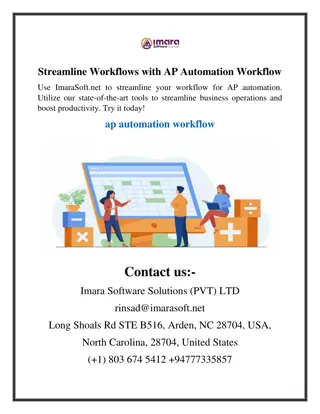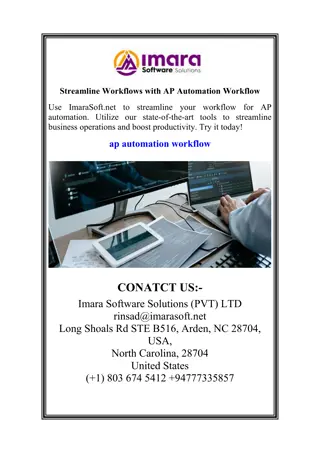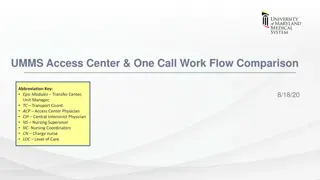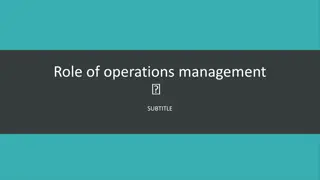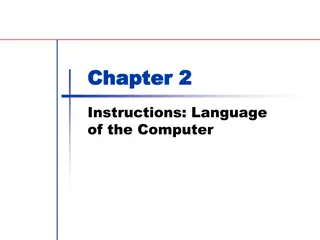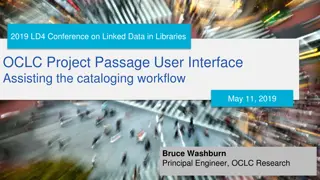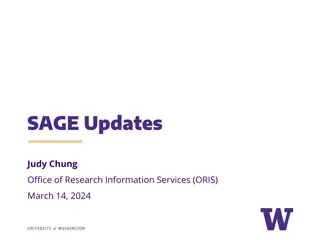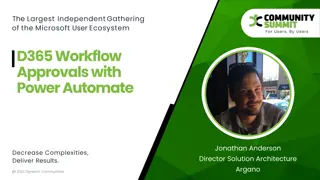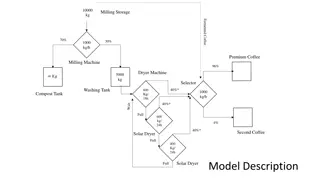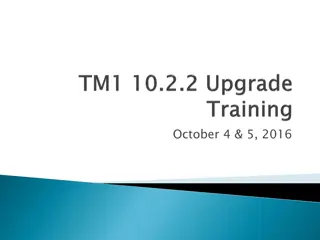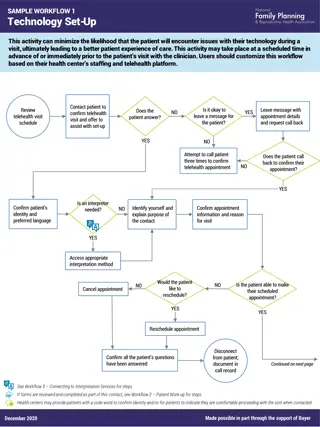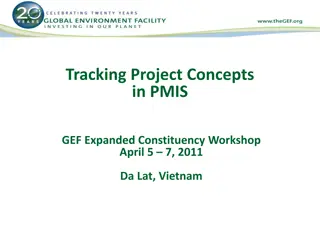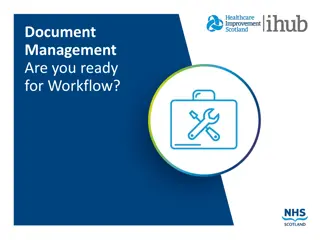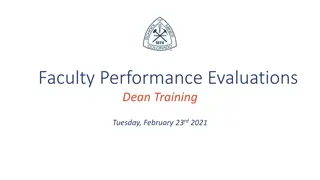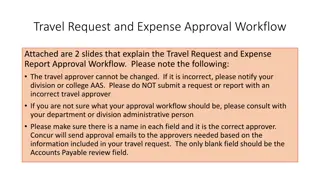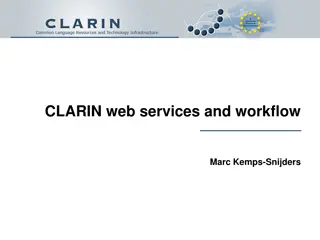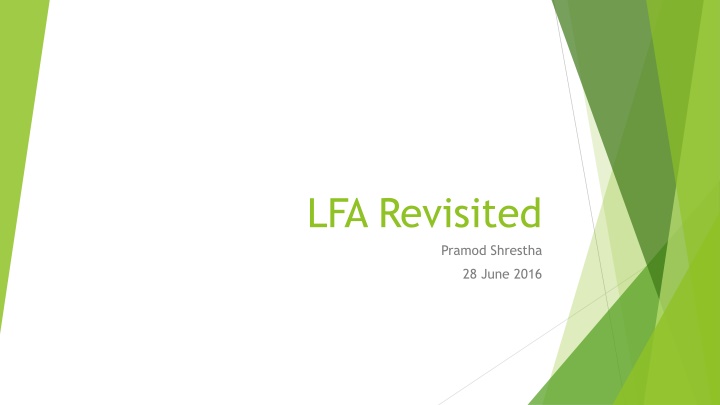
Improving Project Workflow for Efficient Operations
Enhance project workflow with a focus on increasing capacity, consultant selection, and process improvement in engineering and architectural services. The portfolio overview highlights a diverse client base and significant statewide agreements. Strategies include new JOC contracts, increased fee ceilings, and fielding enterprise software solutions for better project management. Updated policies, procedures, and forms aim to streamline operations and ensure project success.
Download Presentation

Please find below an Image/Link to download the presentation.
The content on the website is provided AS IS for your information and personal use only. It may not be sold, licensed, or shared on other websites without obtaining consent from the author. If you encounter any issues during the download, it is possible that the publisher has removed the file from their server.
You are allowed to download the files provided on this website for personal or commercial use, subject to the condition that they are used lawfully. All files are the property of their respective owners.
The content on the website is provided AS IS for your information and personal use only. It may not be sold, licensed, or shared on other websites without obtaining consent from the author.
E N D
Presentation Transcript
LFA Revisited Pramod Shrestha 28 June 2016
Why LFA ? Relevant, feasible and sustainable projects. To overcome major errors in planning structure! All key stakeholders participation & efficiency, correct situation analysis correct solutions (activities) Shared understanding of the situation and of different needs and interest - transparency ! Ownership and responsibility
A logical approach to programme management A systematic and structured process and way of thinking A in which the process itself is just as important as the product Cause and effect relationships between actions and effects Necessary conditions Responsibilities B Timeframe Results measurement
Two main phases of project formulation Analysis phase Planning phase Project elements Defining project structure, testing its internal logic and risks. Formulating measurable indicators of success Assumptions Determining the sequence and dependency of duration and assigning responsibility Stakeholder analysis Identifying and characterizing potential major stakeholders; assessing their capacity Problem analysis Identifying key problems, constraints and opportunities; determining cause and effect relationship Objective analysis Developing solutions from the identified problem; identifying means-to-end relationship Alternative analysis Identifying different strategies to achieve solutions; selecting the most appropriate strategy Indicators
The results chain Impact Based on causality, attribution and contribution Hope to see Long-term development improvements to which we contribute Outcomes Want to see Immediate effects on clients Beyond team control but achievable given necessary conditions Outputs Expect to see The end products and services; deliverables from the activities; within team control Activities Actions undertaken to transform inputs into outputs Inputs Financial human and material resources
The typical RBM planning process Participation/Stakeholder analysis identify who has an interest and who needs to be involved Problem analysis identify key problems, causes and opportunities; determine causes and effects Analysis phase A Objectives analysis identify possible solutions Alternative analysis identify and apply criteria to agree strategy Design phase Developing the plan framework define result chain, logic, risk and performance management B Workplanning set a workplan and assign responsibilities Budgeting determine human and material inputs needed
Partnership? Who s driving the bus? Who owns the bus? Who paid for the vehicle? Who s maintaining it? Who decides where it goes? When? How? Via? Who s a passenger? inside? on the roof? hanging on? walking? Who s paying? Who s getting a free-ride? Who built the road? Who are the police? Who are you?
Impact Then will we contribute to this Impact? Check the logic using if then If we achieve this Outcome Then will we achieve this Outcome? If we deliver these Outputs Then will we deliver these Outputs? If we carry out these Activities Start here
Sequence Impact Check the logic UP Plan DOWN Outcome Output Activities
Why a Problem Tree? Problem Tree Effects Objective Tree Overall objectives Focal problem Project Purpose Causes Results
PROBLEM ANALYSIS is CRUCIAL! As with weeds, the roots must be tackled, if the weeds are to disappear
Analysing the problem Addressing the effects identifies possible indicators EFFECTS Turning the problem into a positive statement gives the outcome or impact Focal Problem CAUSES Addressing the causes identifies possible outputs and activities
Risks and assumptions Risk A potential event or occurrence beyond the control of the programme that could adversely affect achievement of the desired results.* Assumption A necessary condition for the achievement of results at different levels. UNDG Technical Brief: Risks and Assumptions (2008)
Risk and assumptions some key messages
Key questions in risk analysis IMPACT? depends mainly on: What is the HAZARD itself? Scale? Seriousness? What is the VULNERABILITY to the hazard? of the poor? of the project? PROBABILITY? The likelihood of it happening. Data? Reliability of data? COSTS? What are the costs of taking the risk? Social? Financial? Political? Who bears them? The already vulnerable? GAINS? What are the gains from going ahead? MITIGATION? What can be done to improve any or all the above?
Risk analysis an example I ve had your results back and I m concerned about your cholesterol level. Think through how you would analyse this
Risk analysis an example The Hazard is the high cholesterol level. I m male, over 55, with a family history of strokes, so my Vulnerability is medium to high. Put these two together and the Impact is (no denying it) high Continue at these levels, and you ve a 30% chance of a major heart problem by 70. So that s the Probability. I d better cut out the cheese, and cream and butter; and eat loads of oats and fish. I reckon that s a Cost worth bearing. Get these levels down and you can assume halving the probability.
Risks and assumptions An assumption is not the mirror image of a risk. CatAndMirror-799191%5B1%5D It is not a risk, written positively; e.g. risk - inflation; assumption - no inflation
Risk analysis table Impact Probability Risks Mitigation Assumptions Airport security screening of all passengers. Screening is sufficiently effective to reduce the risk of highjacking to an acceptable level. Highjacking of aircraft Very High Medium Deterioration of security situation disrupts project results Develop and implement security plan. Liaison with UN security office. Effective preparedness for any deterioration in security; disruption to project results minimised. Medium Low Elite capture of benefits within community Ensure institutional representation of disadvantaged groups. Monitoring of decision- making processes. Transparency such that benefits visibly accrue to disadvantaged at community and household levels. Medium Medium
Re-check the logic using ifand then Impact THEN we will contribute to this Assumptions If we achieve this Outcome THEN we will achieve this Assumptions If Assumptions Outputs THEN we will deliver these we deliver these If Assumptions If Activities we carry out these THEN we will do these these pre-conditions prevail Start here
Terms in performance measurement Indicator a quantitative and/or qualitative variable that allows the verification of changes produced by a development intervention relative to what was planned. Target a specific level of performance that an intervention is projected to accomplish in a given time period. Milestone an indicator used during the lifetime of a plan by which progress, usually of output delivery, can be measured. Baseline the situation prior to a development intervention against which progress can be assessed or comparisons made.
Indicators, targets and milestones Indicators are means; the proportion of population below $1 per day Targets are ends; halve, between 1990 and 2015, the proportion of people whose income is less than $1 a day Milestones are progress checks; reduction by 40% between 1990 and 2010, ..
Essential Qualities of Indicators Validity It measures what it is intended to measure without bias. Reliability It measures accurately the real change, consistently over time and place. Sensitivity It measures small change or progress and reflects differences in key aspects such as gender. Simple It is easy to interpret and understood by all. Practical Data is available when needed at reasonable cost. Useful It is useful for decision-making, planning and learning.
Data Sources What evidence do we need? How do we get it? Available from existing sources? Is special data gathering required? Who will pay for data collection? How much data gathering is worthwhile? Who will collect the evidence? How often and when? Where will it be located?
Performance measurement matrix Unit Result Indicator Data Data sources Collection Methods Frequency Responsible unit / person Description
LFA matrix/Log Frame Overall Objectives Indicators Sources of Verifications Assumptions Project Purpose Indicators Sources of Verifications Assumptions Results Indicators Sources of Verifications Assumptions Activities Resources
7 LFA STEPS 1 STAKEHOLDER ANALYSIS 2 PROBLEM ANALYSIS 3 OBJECTIVES ANALYSIS 4 Alternative Analysis 5 Defining the Main Project Elements 6 ASSUMPTIONS LOG FRAME/MATRIX 7 Establishing Indicators
How the LFA method works depends on its users LFA is no better and no worse than its users
LFA summary Relevant, Feasible and Sustainable projects/programs - success! Participation & ownership! Joint approach to project Make problem analysis with accuracy /time to correctly analyze causes & effects Connection problems and objectives Add analysis such as cost effectiveness and gender, study on environmental aspects and make a clear division of responsibilities LFA during all phases of the project
Internet information on LFA www.google.com/logical framework approach http://www.ausaid.gov.au/ausguide/ausguidelines/1.html http://lgausa.com/logframe_approach.htm http://www.cgiar.org/isnar/gender/hambly.htm http://www.pcm-group.com/services_helpdesk_faq.jsp http://europa.eu.int/comm/europeaid/evaluation/method s/PCM_Manual_EN-march2001.pdf


